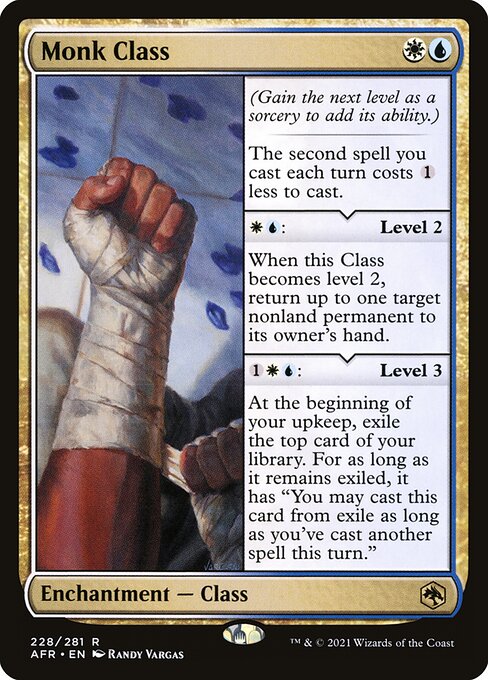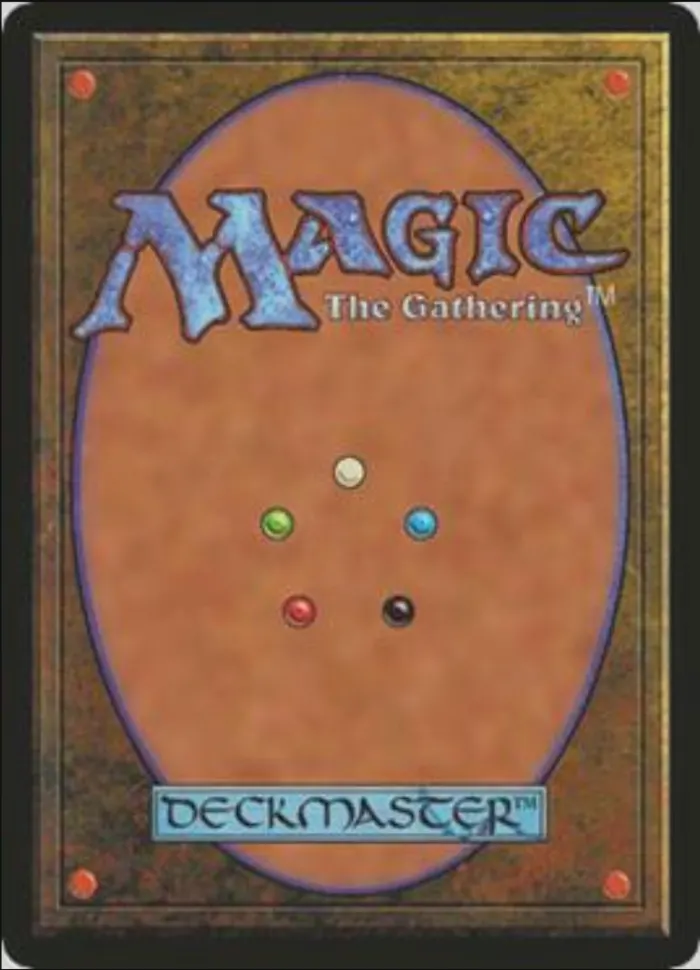Classe : moine
Enchantement : classe
(Acquérez le prochain niveau lorsque vous pourriez lancer un rituel pour ajouter sa capacité.)
Le deuxième sort que vous lancez à chaque tour coûte de moins à lancer.
: Niveau 2
//Level_2//
Quand cette classe devient niveau 2, renvoyez jusqu'à un permanent non-terrain ciblé dans la main de son propriétaire.
: Niveau 3
//Level_3//
Au début de votre entretien, exilez la carte du dessus de votre bibliothèque. Tant qu'elle reste exilée, elle a « Vous pouvez lancer cette carte depuis l'exil tant que vous avez lancé un autre sort ce tour-ci ».
Le deuxième sort que vous lancez à chaque tour coûte de moins à lancer.
: Niveau 2
//Level_2//
Quand cette classe devient niveau 2, renvoyez jusqu'à un permanent non-terrain ciblé dans la main de son propriétaire.
: Niveau 3
//Level_3//
Au début de votre entretien, exilez la carte du dessus de votre bibliothèque. Tant qu'elle reste exilée, elle a « Vous pouvez lancer cette carte depuis l'exil tant que vous avez lancé un autre sort ce tour-ci ».
standard
future
historic
gladiator
pioneer
explorer
modern
legacy
pauper
vintage
penny
commander
brawl
alchemy
paupercommander
duel
oldschool
premodern
Rulings
Gaining a level won't remove abilities that a Class had at a previous level.
Some Class cards have an effect that increases when more are under your control. For example, if you have multiple Barbarian Class cards, you roll that many additional dice and ignore that many of the lowest rolls.
Each Class starts with only the first of three class abilities. As the first level ability resolves, the Class becomes level 2 and gains the second class ability. As the second level ability resolves, the Class becomes level 3 and gains the third class ability.
If you have more than one Monk Class on the battlefield, their abilities are cumulative. For example, if you control two Monk Classes, the second spell you cast each turn costs less to cast.
If Monk Class is the first spell you cast, the next spell is the second spell and costs less. If Monk Class is the second (or later) spell you cast, its bonus won't apply until the next turn.
You can't activate the first level ability of a Class unless that Class is level 1. Similarly, you can't activate the second level ability of a Class unless that Class is level 2.
You can multiclass or even control multiple Class enchantments of the same class. Each Class permanent tracks its own level separately.
Each Class has five abilities. The three in the major sections of its text box are class abilities. Class abilities can be static, activated, or triggered abilities. The other two are level abilities, one activated ability to advance the Class to level 2 and another to advance the Class to level 3.
Gaining a level is a normal activated ability. It uses the stack and can be responded to.
Some Class cards have an effect that increases when more are under your control. For example, if you have multiple Barbarian Class cards, you roll that many additional dice and ignore that many of the lowest rolls.
Each Class starts with only the first of three class abilities. As the first level ability resolves, the Class becomes level 2 and gains the second class ability. As the second level ability resolves, the Class becomes level 3 and gains the third class ability.
If you have more than one Monk Class on the battlefield, their abilities are cumulative. For example, if you control two Monk Classes, the second spell you cast each turn costs less to cast.
If Monk Class is the first spell you cast, the next spell is the second spell and costs less. If Monk Class is the second (or later) spell you cast, its bonus won't apply until the next turn.
You can't activate the first level ability of a Class unless that Class is level 1. Similarly, you can't activate the second level ability of a Class unless that Class is level 2.
You can multiclass or even control multiple Class enchantments of the same class. Each Class permanent tracks its own level separately.
Each Class has five abilities. The three in the major sections of its text box are class abilities. Class abilities can be static, activated, or triggered abilities. The other two are level abilities, one activated ability to advance the Class to level 2 and another to advance the Class to level 3.
Gaining a level is a normal activated ability. It uses the stack and can be responded to.
Rulings
Gaining a level won't remove abilities that a Class had at a previous level.
Some Class cards have an effect that increases when more are under your control. For example, if you have multiple Barbarian Class cards, you roll that many additional dice and ignore that many of the lowest rolls.
Each Class starts with only the first of three class abilities. As the first level ability resolves, the Class becomes level 2 and gains the second class ability. As the second level ability resolves, the Class becomes level 3 and gains the third class ability.
If you have more than one Monk Class on the battlefield, their abilities are cumulative. For example, if you control two Monk Classes, the second spell you cast each turn costs less to cast.
If Monk Class is the first spell you cast, the next spell is the second spell and costs less. If Monk Class is the second (or later) spell you cast, its bonus won't apply until the next turn.
You can't activate the first level ability of a Class unless that Class is level 1. Similarly, you can't activate the second level ability of a Class unless that Class is level 2.
You can multiclass or even control multiple Class enchantments of the same class. Each Class permanent tracks its own level separately.
Each Class has five abilities. The three in the major sections of its text box are class abilities. Class abilities can be static, activated, or triggered abilities. The other two are level abilities, one activated ability to advance the Class to level 2 and another to advance the Class to level 3.
Gaining a level is a normal activated ability. It uses the stack and can be responded to.
Some Class cards have an effect that increases when more are under your control. For example, if you have multiple Barbarian Class cards, you roll that many additional dice and ignore that many of the lowest rolls.
Each Class starts with only the first of three class abilities. As the first level ability resolves, the Class becomes level 2 and gains the second class ability. As the second level ability resolves, the Class becomes level 3 and gains the third class ability.
If you have more than one Monk Class on the battlefield, their abilities are cumulative. For example, if you control two Monk Classes, the second spell you cast each turn costs less to cast.
If Monk Class is the first spell you cast, the next spell is the second spell and costs less. If Monk Class is the second (or later) spell you cast, its bonus won't apply until the next turn.
You can't activate the first level ability of a Class unless that Class is level 1. Similarly, you can't activate the second level ability of a Class unless that Class is level 2.
You can multiclass or even control multiple Class enchantments of the same class. Each Class permanent tracks its own level separately.
Each Class has five abilities. The three in the major sections of its text box are class abilities. Class abilities can be static, activated, or triggered abilities. The other two are level abilities, one activated ability to advance the Class to level 2 and another to advance the Class to level 3.
Gaining a level is a normal activated ability. It uses the stack and can be responded to.
Your collection? Your decks?
Want to manage your collection and/or create decks?

